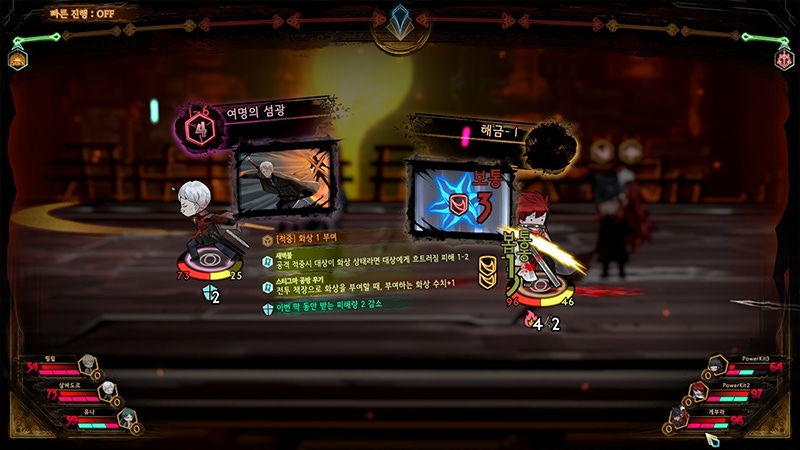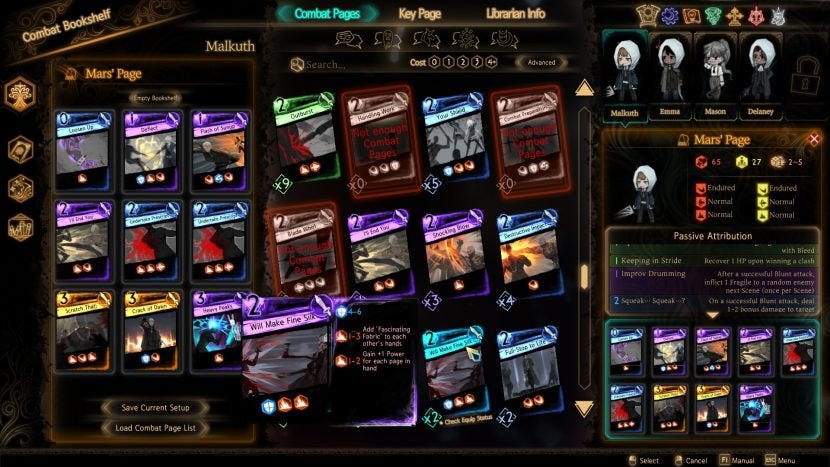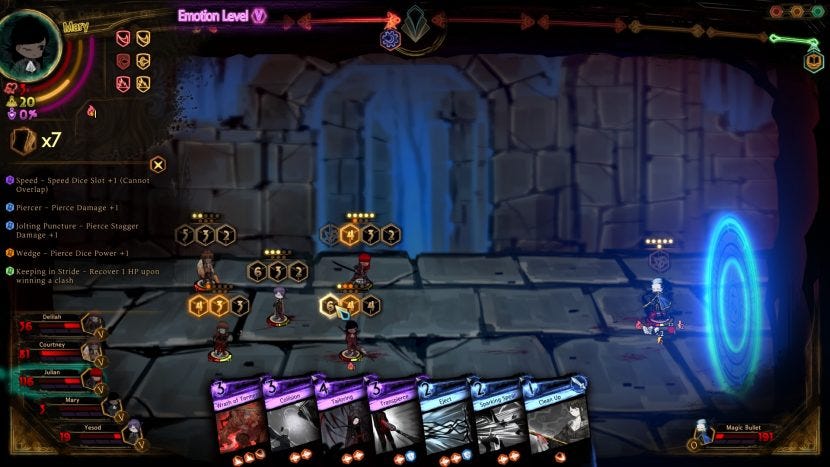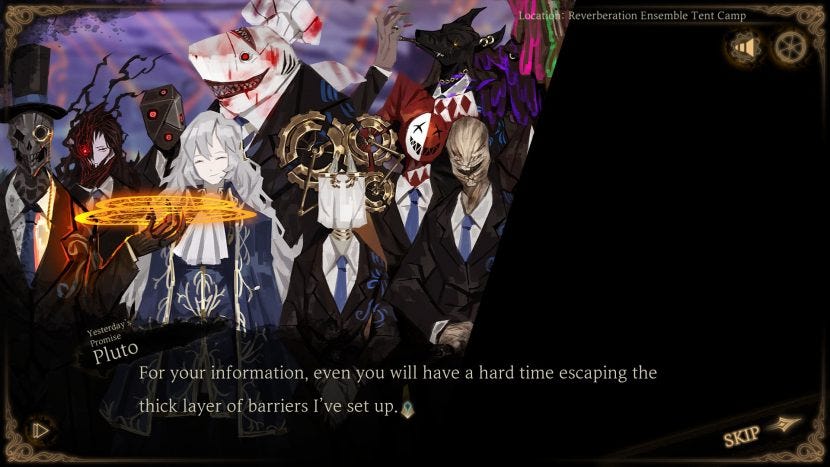Trending
Opinion: How will Project 2025 impact game developers?
The Heritage Foundation's manifesto for the possible next administration could do great harm to many, including large portions of the game development community.

Featured Blog | This community-written post highlights the best of what the game industry has to offer. Read more like it on the Game Developer Blogs or learn how to Submit Your Own Blog Post
My thoughts on Library of Ruina, one of the most unique games released this year that most people have never heard of.

Project Moon is an indie studio that many of you may not have heard about, but in three years have made a name for itself for going outside the box with their games. Their first game Lobotomy Corporation combined management games, roguelites, and SCP fiction, into something uniquely theirs. After several years of development, Library of Ruina is out of early access and there really isn’t any other game like it.
LOR’s story involves a place known as the Library that exists outside of time and space. One day Roland finds himself drawn there and is conscripted by the manager Angela to invite people to the library in order to search for “the one true book.” This is accomplished by fighting people who enter the library and turning them into books and using said books to attract more people to come. Going more into the story of the game would take us into spoiler territory, but let’s just say that fans of Lobotomy Corporation will get a lot out of the plot points.
The structure of the game leans heavily into deck-building design. By defeating guests you’ll unlock their books which can then be burned to access their pages. Pages come in the form of key pages, that affect the base stats (among other things) for a librarian who equips it, and combat pages that are the actual attacks used during combat. The books are also used to unlock new encounters, with different combinations leading to different guests showing up.
Combat is where LOR distinguishes itself from its peers. Every character has health and stagger, if you can reduce someone’s stagger to zero, the next turn they will be unable to attack and will take max damage from any damage type. As you play through the game and defeat more opponents, you’ll start to amass a variety of cards that really begin to build up the depth of the systems here.

The variety of cards, strategies, and builds, can be very overwhelming
Cards can have multiple attacks or defenses and different dice values. When two characters fight, they “clash” and whoever has the higher value will carry out their attack. Defense dice may not seem that important, but one defense move can block multiple attacks when used properly. As you start getting key pages that provide bonuses or additional effects, synergies will start to make themselves known, which becomes very important as the game ramps up.
Like Lobotomy Corporation there is a lot of depth under the surface of LOR. The game does a good job of drip-feeding new mechanics and systems as you play. What starts out with you just fighting as one character in a single area, soon evolves. As more of the library opens up, you’re able to select which wing you’ll do battle in with librarians who are locked to each wing. Every librarian has the same base stats, with the pages you attach to them dictating their abilities. Damage persists across fights in a battle, and different encounters may allow you to switch to different wings and use them as backup.
Early on, you’ll begin to unlock more challenges in the form of abnormality fights (which should perk up the ears of Lobotomy Corporation fans). The abnormalities can only be fought by whoever is stationed in that wing and will often require you to shuffle around key and combat pages. These fights are more akin to puzzle encounters, as every abnormality has unique rules and status abilities governing the fight. One boss will do vastly less damage as long as they have a debuff on them, while another may be immune to specific damage types. There is no penalty for losing to an abnormality fight, and you are free to repeat and try new strategies as much as you want.

Don’t be surprised to encounter multi-phase fights as you get further in
You will need to complete every abnormality in order to move the story along; they do unlock the ability to field more librarians in that wing and provide you with abnormality pages during combat. If you do well in a fight, you’ll get to choose an abnormality page from your unlocks randomly. These pages can affect the fight and could be the lynchpin in whether or not you win. One of my favorite pages will cause whoever uses it to die in three turns, but for those three turns, they become nigh-unkillable and have all their stats super boosted. During one rampage, my one character killed three enemies on their own before the time was up. As the game goes on, you’ll start to see rarer cards and books show up from the enemies that you defeat. The very best key pages can provide you with more attacks per turn, no weaknesses to damage types, and more. You’ll eventually unlock the option to take passives from pages and apply them to another, creating even more potential for powerful synergies.
Even when you think that there’s nothing more for the game to unlock, you’ll also get access to late game challenges that can unlock library wing-specific super cards and exclusive cards to specific key pages. This is definitely not a game that plays its hand within the first 20 minutes; hours in I was still seeing new card rules and enemies and bosses that would break previously established ones.
Another reason for playing is the story. The world of The Library and “The City” that surrounds it paints a very unique picture, drawing from dystopian futures, cyberpunk, and more. Before each new encounter, you get a small visual novel scene where you see the people who you will end up killing discuss their lives and learn more about just how disturbing the city is. The vignettes go all over the place and get stranger as you get further in. And for another reason, the music in the game is outstanding, with a variety of songs and themes that go all over the place.
LOR stands alone in terms of its combination of deck building and visual novel storytelling, but that also makes it a little daunting to get into.
For lack of a better way of describing it, LOR can be exhausting to play compared to the other deck builders on the market. This is not a game about adapting as you go or making random drops work, but one of planning, planning, and getting lucky with dice rolls. And with that planning, I feel the game could have done a better job of making that easier as you get further in.
The first two to three hours of playing LOR gives you a lot of leeway in terms of difficulty. With exception to abnormality rules, you can get by most encounters without tweaking things too much. Once you make it to the fourth chapter of stories, the game begins to hit back hard. Expect enemy encounter to either outnumber your party or be able to attack multiple times per character. There is a particular boss fight that occurs that I’m sure will go on to define a difficulty spike for a lot of people. From there, the game introduces multiple bosses into chapter five, including six and seven-phase bosses to fight. When you fail a battle, you will need to use the same books to try it again, and not having them will require you to repeat earlier battles.

This is one of the more "normal" scenes I can show of the story
At this point, you’re going to need to go back to the drawing board, and this is where the UI stumbles. The number of combat pages you’re going to get access to could easily fit one of the larger CCGs in terms of sheer volume. Like CCGs on the market, the vast majority of those cards are going to become useless. The design and progression is all about adding in more powerful cards as you get further into the game, and sometimes “punching up” to lose a harder encounter just to get one of their books to unlock their cards. A 1 cost card that does 1–3 points of damage will never be used again when you get a 1 cost that does 3–5 points. All this planning is required as there’s no real way to “grind” in LOR.
There is no experience or leveling up; repeating battles will get you access to more combat cards, but you are still limited to nine cards per librarian. You can use your books to find “general fights” that have different cards, but there is a finite amount of these encounters. The rarest key pages can only exist one at a time and each librarian can only equip one copy of super rare combat pages, so you’re not going to be able to overcome battles that way.
As the game goes on, the depth and complexity of the cards grow. You’ll start to find cards that provide bonuses upon use, ranged cards that have their own ruleset compared to melee, and I’m sure there’s more to be found. All this equates to more time having to be spent planning and making sure that everything is in sync. You are able to “favorite” key pages, and I would highly suggest you favorite all pages that provide multiple attacks per turn to make things easier for you as the game ramps up. The game does feature a “search” command but when I tried to search for cards that did “burn” damage, none of them showed up despite having them available. A UI feature that will become your best friend is the ability to sort pages by what chapter of the game they appear in, as the later chapters have stronger cards.
One final point of annoyance is that until you beat a fight, you’re not able to see before you start what cards/defenses those enemies have, and as you get into the higher chapters, having this information after a failure is very important. It’s very hard to analyze what you did right or wrong during a battle compared to other games. One time I lose a battle horribly, reloaded it with no changes and completely stomped the enemies. The UI is straightforward but also cumbersome in some respect. There is so much information that is thrown at the player that it can become undecipherable if you’re not really paying attention.

In the end game, expect to fight enemies who can easily beat 15 of your characters solo
For me, it got to the point that I need to be in the mood to play LOR compared to that sense of firing up a game like Slay the Spire or Monster Train and have a complete and quick experience. It’s best to approach the game as a deckbuilding RPG, as this is a very involved game to master. While the UI and onboarding have been improved, it can still be hard to learn the concepts of the game, especially how defense and evade work.
Library of Ruina is going to go down as one of those indie games that most people will never hear about but will certainly have a fanbase for those that played it. There really isn’t anything quite like this game and I respect Project Moon for it. If you’re a fan of deck builders and looking for something unique, then definitely check this one out, but the quirks and challenges do make this a hard game for novices to jump into. If you are up for it, this is definitely one of my favorite games of 2021, and one of the most unique games out there.
If you enjoyed my post, consider joining the Game-Wisdom discord channel. It’s open to everyone.
Read more about:
Featured BlogsYou May Also Like